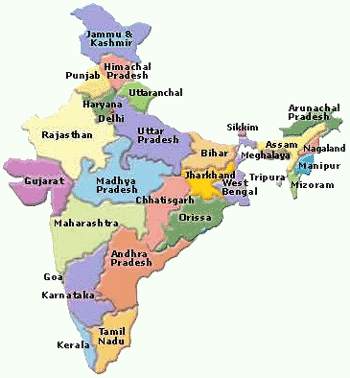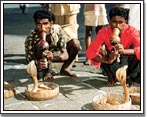|
India 
India has been changing and re-shaping itself for as long as anywhere on earth, forever producing new forms of culture
and absorbing new influences. Visiting the subcontinent, you’ll
see spectacular carved temples and gleaming marble palaces, lonely
Himalayan lamaseries and far-flung dusty villages where council
meetings are held under the shade of a banyan tree, plodding
camels, holy cows, snake charmers and wild-haired sadhus:
you’ll also find a dynamic state racing into the twenty-first
century. The boundaries of modern India, fixed some fifty years
ago, are merely the latest in a four-thousand-year sequence of
redefinitions that have produced one of the most heterogeneous
societies in the world. The land where the Buddha lived and
preached, and where the Moghul Muslims erected the Taj Mahal, has
recreated itself as both a majority Hindu nation and the world’s
largest secular democracy, home to almost one thousand million
people.
Many first-time visitors cannot see
past the grinding poverty of the country’s most disadvantaged
citizens. Others expect a timeless ascetic wonderland and are
indignant to find that materialism has its place here too. Still
more find themselves intimidated by what may seem, initially, an
incomprehensible and bewildering continent.
This guide is intended to lead you
through the states, cities and towns of India, offering
historical, architectural and cultural information to enrich your
trip, whether you intend to travel for a few weeks or several
months. The guide’s intention is to spare you the mistakes and
anti-climaxes that can spoil the best-laid plans, and to direct
you towards off-beat delights as well as world-famous landmarks.
It covers specific states and regions by introducing the major
sights, surveying the history, and summarizing the major travel
routes. In each town we’ve detailed the best places to stay and
eat, reviewing palace hotels of faded grandeur alongside
inexpensive lodges and simple pilgrim guesthouses, and Mughlai
restaurants next to village food stalls. We haven’t set out to
list the cheapest options everywhere, because in India, as
anywhere else, the cheapest can easily be the worst. As well as
providing detailed accounts of all the major sights, we provide
the information you need to search out performing arts, enjoy
Indian cinema, explore ashrams and religious centers, and get
swept away by the fervors of the great festivals.
 The best Indian itineraries are the
simplest. To imagine that there is some set list of places you
must go, or things you must see, is a sure way to make your trip
self-defeating. You couldn’t see everything in one expedition,
even if you spent a year trying. Far better then, to concentrate
on one or two specific regions, and above all, to be flexible.
Although it requires a deliberate change of pace to venture away
from the cities, rural India has its own very distinct pleasures.
In fact, while Indian cities are undoubtedly adrenalin-fuelled,
upbeat places, it is possible – and certainly less stressful –
to travel for months around the subcontinent and rarely have to
set foot in one. The best Indian itineraries are the
simplest. To imagine that there is some set list of places you
must go, or things you must see, is a sure way to make your trip
self-defeating. You couldn’t see everything in one expedition,
even if you spent a year trying. Far better then, to concentrate
on one or two specific regions, and above all, to be flexible.
Although it requires a deliberate change of pace to venture away
from the cities, rural India has its own very distinct pleasures.
In fact, while Indian cities are undoubtedly adrenalin-fuelled,
upbeat places, it is possible – and certainly less stressful –
to travel for months around the subcontinent and rarely have to
set foot in one.
The information under Basics
provides an overview of the practical aspects of travelling in
India. To put it simply, it’s not as difficult as you may
imagine, or may be told. Some travellers impose an exhausting
sequence of long-distance journeys and other privations upon
themselves that no Indian would dream of attempting, and then
wonder why they’re not enjoying their trip. Although becoming
overtired is an almost inevitable part of travelling around India,
getting ill – despite the interminable tales of Delhi-belly and
associated hardships so proudly told by a certain type of India
bore – certainly isn’t. If you give yourself time to rest
there’s no reason why you should pick up anything worse than a
headache. Food is generally extremely good, especially in south
India, famed for its creative vegetarian cuisine; water can be
bought in bottles, just like anywhere else in the world, and there
are plenty of comfortable, inexpensive places to stay. Though the
sheer size of the country means that travel is seldom
straightforward, the extensive road, rail and air links ensure
that few destinations are inaccessible, and fares are invariably
cheap. Furthermore, the widespread use of English makes
communication easy for the majority of Western visitors. Journeys
may be long – a four-hour bus ride is normal, and travelling
constantly for thirty hours not uncommon – but they can provide
some of the very best moments of a trip: punctuated with frequent
food stops and memorable encounters, and passing through an
everchanging landscape. For long hauls, much the best way to go is
by train; with computerized booking now established almost
everywhere, the Indian rail network is as efficient as almost any
in the world. Rail journeys also offer the chance to meet other
travellers and Indians from all walks of life, and a constant
stream of activity as chai-wallahs, peanut-sellers,
musicians, astrologers and mendicants wander through the
carriages.
|
